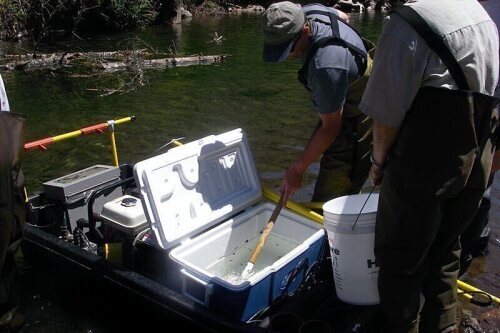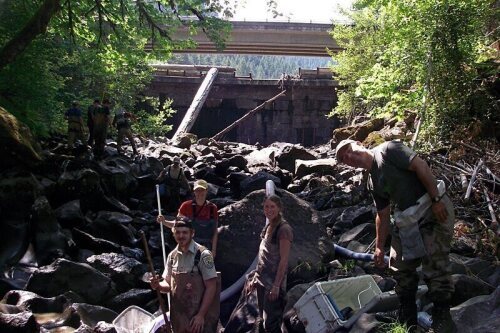Smith-Root Staff
Monday, March 22, 2010Hemlock Dam (Trout Creek, Wind River watershed in southwest Washington) was de-watered prior to dismantling in the summer of 2009 to allow unobstructed upstream/downstream passage of Lower Columbia River steelhead, an ESA-listed species. Smith-Root, Inc. is proud to have supported this effort by sending staff biologist, Lisa Harlan, along with Smith-Root backpack electrofishers (LR-24s), to assist in removing fish as the stream above and below the dam was de-watered. The removal of fish was accomplished using backpack electrofishers, a tote-barge equipped with a 5.0 GPP Electrofisher and lots of nets and personnel. Thousands of listed steelhead were rescued over the 3-day work period.
Hemlock Dam, an aging concrete structure that once provided power and later irrigation to the CCC and Forest Service will be dismantled to improve habitat, water quality and passage for Lower Columbia River steelhead. The dam no longer produces power or irrigation storage, but continues to affect steelhead by impeding upstream and downstream movement of the fish, increasing water temperatures in lower Trout Creek, and obstructing downstream movement of valuable stream sediments.
Trout Creek is located in the Wind River watershed in southwest Washington. The Wind River is a Tier I Key Watershed on the Gifford Pinchot National Forest, and as such is a top priority for aquatic habitat restoration. Trout Creek provides critical habitat for Lower Columbia River steelhead, a fish listed as Threatened under the Endangered Species Act. This project will improve conditions for the fish and restore natural riverine processes to lower Trout Creek. Trout Creek was once known for producing a disproportionately large share of the wild steelhead in the Wind River, and this project aims to help restore that mantle.



